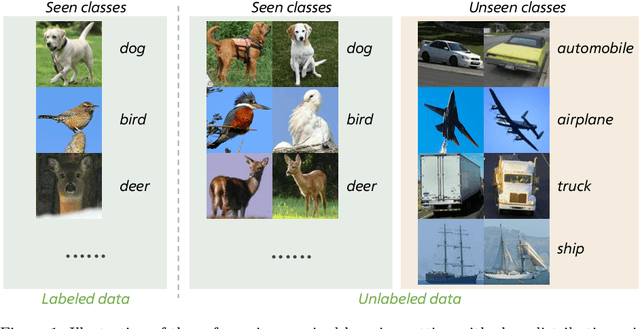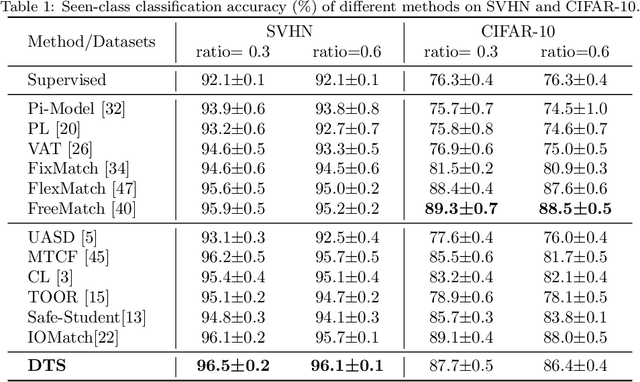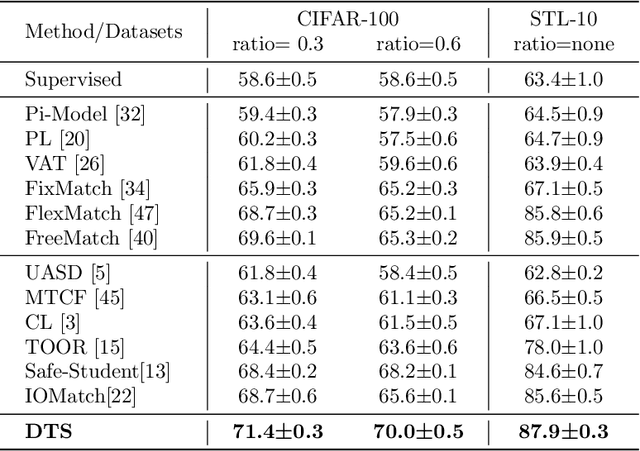Yilong Yin
A Conditional Probability Framework for Compositional Zero-shot Learning
Jul 23, 2025Abstract:Compositional Zero-Shot Learning (CZSL) aims to recognize unseen combinations of known objects and attributes by leveraging knowledge from previously seen compositions. Traditional approaches primarily focus on disentangling attributes and objects, treating them as independent entities during learning. However, this assumption overlooks the semantic constraints and contextual dependencies inside a composition. For example, certain attributes naturally pair with specific objects (e.g., "striped" applies to "zebra" or "shirts" but not "sky" or "water"), while the same attribute can manifest differently depending on context (e.g., "young" in "young tree" vs. "young dog"). Thus, capturing attribute-object interdependence remains a fundamental yet long-ignored challenge in CZSL. In this paper, we adopt a Conditional Probability Framework (CPF) to explicitly model attribute-object dependencies. We decompose the probability of a composition into two components: the likelihood of an object and the conditional likelihood of its attribute. To enhance object feature learning, we incorporate textual descriptors to highlight semantically relevant image regions. These enhanced object features then guide attribute learning through a cross-attention mechanism, ensuring better contextual alignment. By jointly optimizing object likelihood and conditional attribute likelihood, our method effectively captures compositional dependencies and generalizes well to unseen compositions. Extensive experiments on multiple CZSL benchmarks demonstrate the superiority of our approach. Code is available at here.
DPR: Diffusion Preference-based Reward for Offline Reinforcement Learning
Mar 03, 2025



Abstract:Offline preference-based reinforcement learning (PbRL) mitigates the need for reward definition, aligning with human preferences via preference-driven reward feedback without interacting with the environment. However, the effectiveness of preference-driven reward functions depends on the modeling ability of the learning model, which current MLP-based and Transformer-based methods may fail to adequately provide. To alleviate the failure of the reward function caused by insufficient modeling, we propose a novel preference-based reward acquisition method: Diffusion Preference-based Reward (DPR). Unlike previous methods using Bradley-Terry models for trajectory preferences, we use diffusion models to directly model preference distributions for state-action pairs, allowing rewards to be discriminatively obtained from these distributions. In addition, considering the particularity of preference data that only know the internal relationships of paired trajectories, we further propose Conditional Diffusion Preference-based Reward (C-DPR), which leverages relative preference information to enhance the construction of the diffusion model. We apply the above methods to existing offline reinforcement learning algorithms and a series of experiment results demonstrate that the diffusion-based reward acquisition approach outperforms previous MLP-based and Transformer-based methods.
Towards Macro-AUC oriented Imbalanced Multi-Label Continual Learning
Dec 24, 2024



Abstract:In Continual Learning (CL), while existing work primarily focuses on the multi-class classification task, there has been limited research on Multi-Label Learning (MLL). In practice, MLL datasets are often class-imbalanced, making it inherently challenging, a problem that is even more acute in CL. Due to its sensitivity to imbalance, Macro-AUC is an appropriate and widely used measure in MLL. However, there is no research to optimize Macro-AUC in MLCL specifically. To fill this gap, in this paper, we propose a new memory replay-based method to tackle the imbalance issue for Macro-AUC-oriented MLCL. Specifically, inspired by recent theory work, we propose a new Reweighted Label-Distribution-Aware Margin (RLDAM) loss. Furthermore, to be compatible with the RLDAM loss, a new memory-updating strategy named Weight Retain Updating (WRU) is proposed to maintain the numbers of positive and negative instances of the original dataset in memory. Theoretically, we provide superior generalization analyses of the RLDAM-based algorithm in terms of Macro-AUC, separately in batch MLL and MLCL settings. This is the first work to offer theoretical generalization analyses in MLCL to our knowledge. Finally, a series of experimental results illustrate the effectiveness of our method over several baselines. Our codes are available at https://github.com/ML-Group-SDU/Macro-AUC-CL.
Dynamic Prompt Allocation and Tuning for Continual Test-Time Adaptation
Dec 12, 2024Abstract:Continual test-time adaptation (CTTA) has recently emerged to adapt a pre-trained source model to continuously evolving target distributions, which accommodates the dynamic nature of real-world environments. To mitigate the risk of catastrophic forgetting in CTTA, existing methods typically incorporate explicit regularization terms to constrain the variation of model parameters. However, they cannot fundamentally resolve catastrophic forgetting because they rely on a single shared model to adapt across all target domains, which inevitably leads to severe inter-domain interference. In this paper, we introduce learnable domain-specific prompts that guide the model to adapt to corresponding target domains, thereby partially disentangling the parameter space of different domains. In the absence of domain identity for target samples, we propose a novel dynamic Prompt AllocatIon aNd Tuning (PAINT) method, which utilizes a query mechanism to dynamically determine whether the current samples come from a known domain or an unexplored one. For known domains, the corresponding domain-specific prompt is directly selected, while for previously unseen domains, a new prompt is allocated. Prompt tuning is subsequently performed using mutual information maximization along with structural regularization. Extensive experiments on three benchmark datasets demonstrate the effectiveness of our PAINT method for CTTA. We have released our code at https://github.com/Cadezzyr/PAINT.
Unveiling the Superior Paradigm: A Comparative Study of Source-Free Domain Adaptation and Unsupervised Domain Adaptation
Nov 24, 2024Abstract:In domain adaptation, there are two popular paradigms: Unsupervised Domain Adaptation (UDA), which aligns distributions using source data, and Source-Free Domain Adaptation (SFDA), which leverages pre-trained source models without accessing source data. Evaluating the superiority of UDA versus SFDA is an open and timely question with significant implications for deploying adaptive algorithms in practical applications. In this study, we demonstrate through predictive coding theory and extensive experiments on multiple benchmark datasets that SFDA generally outperforms UDA in real-world scenarios. Specifically, SFDA offers advantages in time efficiency, storage requirements, targeted learning objectives, reduced risk of negative transfer, and increased robustness against overfitting. Notably, SFDA is particularly effective in mitigating negative transfer when there are substantial distribution discrepancies between source and target domains. Additionally, we introduce a novel data-model fusion scenario, where data sharing among stakeholders varies (e.g., some provide raw data while others provide only models), and reveal that traditional UDA and SFDA methods do not fully exploit their potential in this context. To address this limitation and capitalize on the strengths of SFDA, we propose a novel weight estimation method that effectively integrates available source data into multi-SFDA (MSFDA) approaches, thereby enhancing model performance within this scenario. This work provides a thorough analysis of UDA versus SFDA and advances a practical approach to model adaptation across diverse real-world environments.
KNN Transformer with Pyramid Prompts for Few-Shot Learning
Oct 14, 2024Abstract:Few-Shot Learning (FSL) aims to recognize new classes with limited labeled data. Recent studies have attempted to address the challenge of rare samples with textual prompts to modulate visual features. However, they usually struggle to capture complex semantic relationships between textual and visual features. Moreover, vanilla self-attention is heavily affected by useless information in images, severely constraining the potential of semantic priors in FSL due to the confusion of numerous irrelevant tokens during interaction. To address these aforementioned issues, a K-NN Transformer with Pyramid Prompts (KTPP) is proposed to select discriminative information with K-NN Context Attention (KCA) and adaptively modulate visual features with Pyramid Cross-modal Prompts (PCP). First, for each token, the KCA only selects the K most relevant tokens to compute the self-attention matrix and incorporates the mean of all tokens as the context prompt to provide the global context in three cascaded stages. As a result, irrelevant tokens can be progressively suppressed. Secondly, pyramid prompts are introduced in the PCP to emphasize visual features via interactions between text-based class-aware prompts and multi-scale visual features. This allows the ViT to dynamically adjust the importance weights of visual features based on rich semantic information at different scales, making models robust to spatial variations. Finally, augmented visual features and class-aware prompts are interacted via the KCA to extract class-specific features. Consequently, our model further enhances noise-free visual representations via deep cross-modal interactions, extracting generalized visual representation in scenarios with few labeled samples. Extensive experiments on four benchmark datasets demonstrate the effectiveness of our method.
Diverse Teacher-Students for Deep Safe Semi-Supervised Learning under Class Mismatch
May 25, 2024



Abstract:Semi-supervised learning can significantly boost model performance by leveraging unlabeled data, particularly when labeled data is scarce. However, real-world unlabeled data often contain unseen-class samples, which can hinder the classification of seen classes. To address this issue, mainstream safe SSL methods suggest detecting and discarding unseen-class samples from unlabeled data. Nevertheless, these methods typically employ a single-model strategy to simultaneously tackle both the classification of seen classes and the detection of unseen classes. Our research indicates that such an approach may lead to conflicts during training, resulting in suboptimal model optimization. Inspired by this, we introduce a novel framework named Diverse Teacher-Students (\textbf{DTS}), which uniquely utilizes dual teacher-student models to individually and effectively handle these two tasks. DTS employs a novel uncertainty score to softly separate unseen-class and seen-class data from the unlabeled set, and intelligently creates an additional ($K$+1)-th class supervisory signal for training. By training both teacher-student models with all unlabeled samples, DTS can enhance the classification of seen classes while simultaneously improving the detection of unseen classes. Comprehensive experiments demonstrate that DTS surpasses baseline methods across a variety of datasets and configurations. Our code and models can be publicly accessible on the link https://github.com/Zhanlo/DTS.
Can We Treat Noisy Labels as Accurate?
May 21, 2024



Abstract:Noisy labels significantly hinder the accuracy and generalization of machine learning models, particularly due to ambiguous instance features. Traditional techniques that attempt to correct noisy labels directly, such as those using transition matrices, often fail to address the inherent complexities of the problem sufficiently. In this paper, we introduce EchoAlign, a transformative paradigm shift in learning from noisy labels. Instead of focusing on label correction, EchoAlign treats noisy labels ($\tilde{Y}$) as accurate and modifies corresponding instance features ($X$) to achieve better alignment with $\tilde{Y}$. EchoAlign's core components are (1) EchoMod: Employing controllable generative models, EchoMod precisely modifies instances while maintaining their intrinsic characteristics and ensuring alignment with the noisy labels. (2) EchoSelect: Instance modification inevitably introduces distribution shifts between training and test sets. EchoSelect maintains a significant portion of clean original instances to mitigate these shifts. It leverages the distinct feature similarity distributions between original and modified instances as a robust tool for accurate sample selection. This integrated approach yields remarkable results. In environments with 30% instance-dependent noise, even at 99% selection accuracy, EchoSelect retains nearly twice the number of samples compared to the previous best method. Notably, on three datasets, EchoAlign surpasses previous state-of-the-art techniques with a substantial improvement.
Off-OAB: Off-Policy Policy Gradient Method with Optimal Action-Dependent Baseline
May 04, 2024



Abstract:Policy-based methods have achieved remarkable success in solving challenging reinforcement learning problems. Among these methods, off-policy policy gradient methods are particularly important due to that they can benefit from off-policy data. However, these methods suffer from the high variance of the off-policy policy gradient (OPPG) estimator, which results in poor sample efficiency during training. In this paper, we propose an off-policy policy gradient method with the optimal action-dependent baseline (Off-OAB) to mitigate this variance issue. Specifically, this baseline maintains the OPPG estimator's unbiasedness while theoretically minimizing its variance. To enhance practical computational efficiency, we design an approximated version of this optimal baseline. Utilizing this approximation, our method (Off-OAB) aims to decrease the OPPG estimator's variance during policy optimization. We evaluate the proposed Off-OAB method on six representative tasks from OpenAI Gym and MuJoCo, where it demonstrably surpasses state-of-the-art methods on the majority of these tasks.
Unleashing the Power of Multi-Task Learning: A Comprehensive Survey Spanning Traditional, Deep, and Pretrained Foundation Model Eras
Apr 29, 2024



Abstract:MTL is a learning paradigm that effectively leverages both task-specific and shared information to address multiple related tasks simultaneously. In contrast to STL, MTL offers a suite of benefits that enhance both the training process and the inference efficiency. MTL's key advantages encompass streamlined model architecture, performance enhancement, and cross-domain generalizability. Over the past twenty years, MTL has become widely recognized as a flexible and effective approach in various fields, including CV, NLP, recommendation systems, disease prognosis and diagnosis, and robotics. This survey provides a comprehensive overview of the evolution of MTL, encompassing the technical aspects of cutting-edge methods from traditional approaches to deep learning and the latest trend of pretrained foundation models. Our survey methodically categorizes MTL techniques into five key areas: regularization, relationship learning, feature propagation, optimization, and pre-training. This categorization not only chronologically outlines the development of MTL but also dives into various specialized strategies within each category. Furthermore, the survey reveals how the MTL evolves from handling a fixed set of tasks to embracing a more flexible approach free from task or modality constraints. It explores the concepts of task-promptable and -agnostic training, along with the capacity for ZSL, which unleashes the untapped potential of this historically coveted learning paradigm. Overall, we hope this survey provides the research community with a comprehensive overview of the advancements in MTL from its inception in 1997 to the present in 2023. We address present challenges and look ahead to future possibilities, shedding light on the opportunities and potential avenues for MTL research in a broad manner. This project is publicly available at https://github.com/junfish/Awesome-Multitask-Learning.
 Add to Chrome
Add to Chrome Add to Firefox
Add to Firefox Add to Edge
Add to Edge